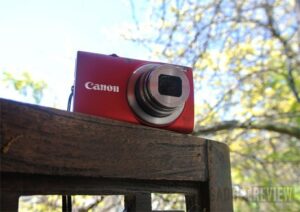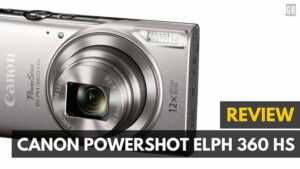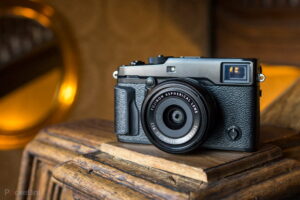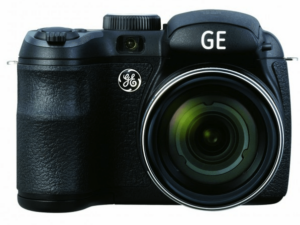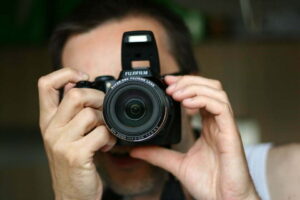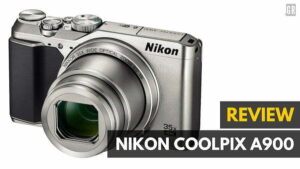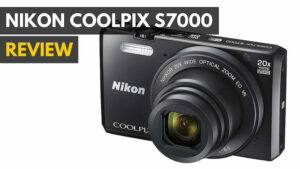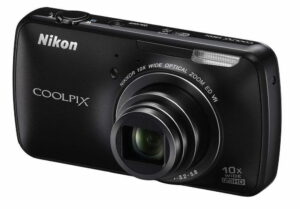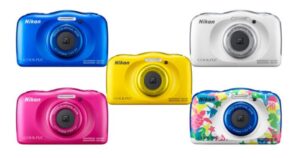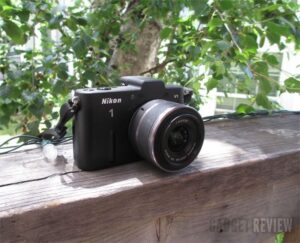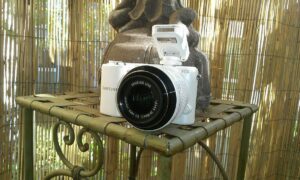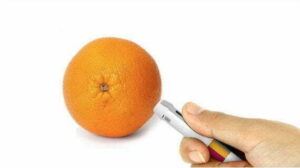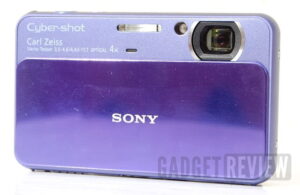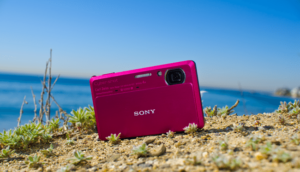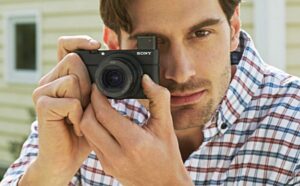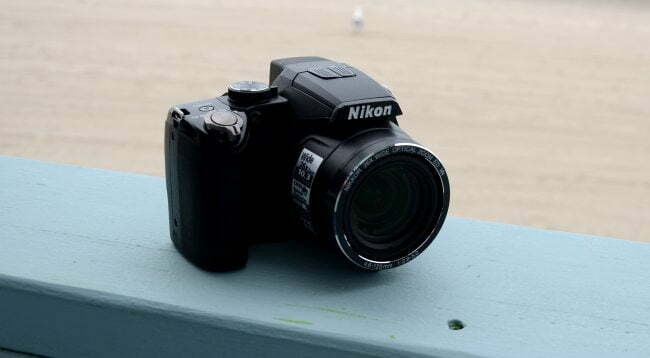
[Rating: 4]
Every camera has limitations. It’s inherent in all products. Sacrifice one aspect for another, like higher quality materials for a higher price or less functionality. With superzooms, quality usually falters because a good zoom lens is expensive. Many wonder why bother spending so much when low-end DSLRs barely cost more. As camera technology progresses, those inherent weaknesses dissipate and prices become more attractive. Quality improves, only sacrificing the time it took to research those improvements. If you’re looking for more great cameras, then read our best digital camera list.
Nikon’s Coolpix P100 is a fine testament to that, packed to the brim with excellent features and a 26x zoom lens. But is it good enough to get, or wait for the next round of technological leaps?
The P100 has a 10.3 megapixel sensor capable of shooting 1080p video at up to 30 frames per second. The 26x zoom lens is a 4.6-120mm and 1:2.8-5.0, which is extremely good considering the form factor. It’s a very fast lens with a focal length of 26-678mm. The P100 also has a high-speed video option for 320×240 resolution at 240 frames per second video, 640×480 at 120fps, and 720p at 60fps. ISO sensitivity is fairly standard with 160-3200, though automatic settings limit it to a max of 800.
Considering the specs, the P100 isn’t just a superzoom, it’s an all-around compact camera fully capable of providing high quality pictures on the level of a DSLR. The only thing that’s missing is RAW shooting, which is a shame. Had the P100 included RAW shooting, it could contend with similarly priced low-end DSLRs. This of course could threaten Nikon’s own line of starter DSLRs. Still, if it had RAW it would absolutely be a serious contender with many DSLR cameras.
DSLR owners will immediately be familiar with the shape and feature layout, as well as all the nobs and buttons on the P100. One dial controls the type of shooting (various manual settings, automatic, scene specific, portrait, sports, etc.) on the top of the frame. That dial is sharp and feels good to turn, a serious piece of metal with a resolute click when changing modes. The power button and shutter release/zoom switch are beside it. The plasticy shutter release contrasts the weighty mode dial. Taking pictures doesn’t feel as solid as changing the mode, in part due to the glossy finish on the shutter release, but also because the button itself doesn’t have the firmness one would expect from a high-grade camera. Ironically, several cellphones recently tested, like the HTC HD7 and Samsung Focus, have stronger shutter releases.
Related: Get more camera info with our Nikon Coolpix L840 review
On the back are a number of controls, including a D-pad for menu navigation and selection, play button to view pictures, menu button, trash, display options, display type and an HD/HS (high definition/high speed) switch and record button for video. One dial by the thumb acts as shutter speed and f/stop dial. ISO must be manually set in the menus. The P100 includes a digital viewfinder, useful in bright conditions, as well as a 3” 226-DPI screen. The electronic viewfinder pales in comparison to the high-quality 3-inch LCD display, but all things considered that’s not such a big deal. The inclusion of a viewfinder is specifically for taking pictures when the screen isn’t easily viewable. The Nikon P100 Digital Camera’s backside illumination CMOS sensor with a 1/2.3” sensor size paired with the EXPEED image processor works well to enhance image quality, which also appears nicely on the 3-inch, 460000 dot LCD display. Overall, this camera has some great additional features to complement your photos and videos. There’s manual shooting modes, image stabilization, optical vibration reduction, and Active D-Lighting to adjust the various tones during your movie recording shoots. The Smart Portrait system is a convenient feature as well.
That screen pops out 90°, which then sits on a second hinge that rotates another 150° so users can shoot accurately either above or below the camera. The display does not swivel left or right. In testing I wasn’t too upset about not having a right/left swivel except when shooting self-video (where the camera faces the user). Without a right/left swivel, users can’t use the P100 to shoot videos of themselves, which may or may not be important. It’s a constant problem I find when shooting video on my Nikon D7000.
Finally, the P100 supports SD/SDHC memory cards, and is rated for 250 shots per charge. In my extended testing of the camera (slow like the Nikon Coolpix S1100pj), I found this number accurate, give or take twenty shots. How much video is shot, as well as the type and with what options, will run the battery down faster. The P100 also outputs via mini-HDMI.
Related: See our Nikon Coolpix S7000 review
One last thing. The P100 obviously uses a rechargeable battery, but unlike most cameras of its size only charges via USB. That is to say users don’t take the battery out to charge it, but plug the entire camera into a cellphone-like charger and let it sit. It’s not a bad thing for if you want to take a few shots at a time and put it away, but if you’re an avid shooter, this charging method will be more work and more fuss with cables and connectors than most cameras offer.
Feel
As I continue to grow as a photographer, using bigger, more expensive and more solid equipment, the general feel of smaller cameras plummets in comparison. This isn’t unexpected…it’s just like watching HDTV for a month will make SD-video feel antiquated. Such is especially true for me, shooting with a high-quality camera like the D7000.
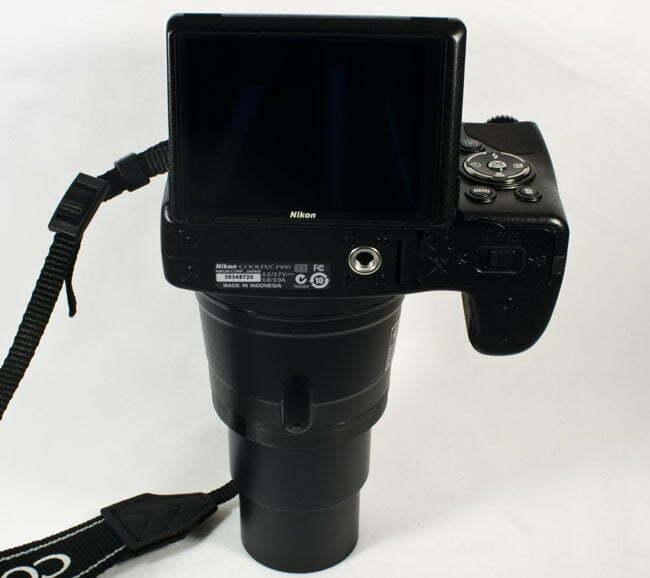
Considering that, the P100 is exceptionally light, almost feeling dinky. But it isn’t, and Nikon intentionally built it for use with one hand, even if your instinct is to hold it with two. We’ll get to the weight in just a bit.
There are a few immediate problems with the P100 from a design standpoint. Flash is controlled by a manual button meaning to use the flash users must manually open the flash and then shoot. It won’t pop up automatically. When the flash is up, the camera will determine whether the shot requires flash or not (in automatic mode), but my concern is that flash should be automatic except in manual shooting modes. Without that speed, shots which would otherwise require flash could be lost in the wind because it isn’t automatically controlled.
The grip is alright, though too roomy. The 3” screen functions well and is bright, but in direct sunlight next to impossible to use. The viewfinder is a nice addition – albeit with a low-resolution screen – though users must press a button to switch between the viewfinder and 3” display. Samsung has a more elegant solution with their NX11 using a proximity sensor. It’s not a serious issue, but a notable nuisance.
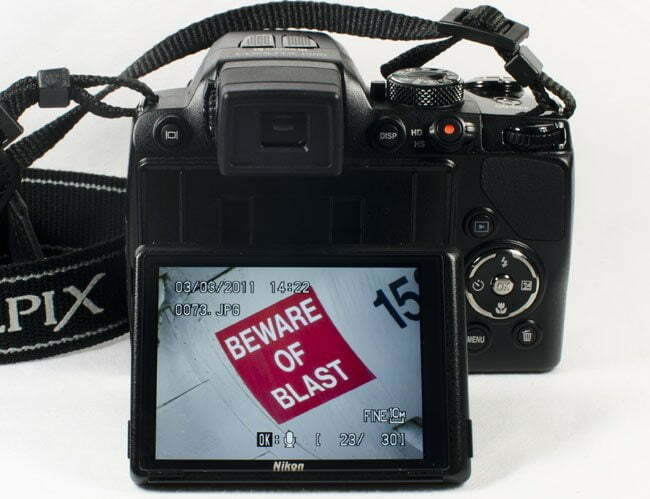
Weight is a bit disconcerting. Carrying the P100 around feels great. It’s light, smaller than a DSLR, and hangs on the neck or shoulder without feeling like a sack of bricks. The problem with being so light is that people with shaky hands may have trouble taking a steady shot, especially shooting with one hand. The convenience of a lightweight camera is extremely important, but the top priority is to picture quality. Shaky shooters should be wary. However, I haven’t had trouble shooting with the P100 due to its lightweight design. This is in part thanks to the fast lens, but also plenty of shooting practice.
More advanced photographers will be annoyed by a few smaller things. The only one way to change the ISO settings is through the menu, which can be rather frustrating if you’re in a low light situation and need to quickly switch to a high ISO. It may be a moot point to most consumers interested in the P100, though I’d liked to have seen Nikon to add an ISO-adjustment button for use with the shutter release/F/stop dial.
The P100 feels great overall, and all of the previously mentioned gripes are small, and certainly not enough to make the camera bad, per se. Carrying it around for a hike or just out on a walk is great. The light design makes it easy to forget you’re wearing it, compared to having several pounds hanging by your neck. At just 17oz, it’s as pleasantly comfortable to use in the home as it is to take on trips.
Picture Quality
With such a fast lens, it should come as no surprise that the P100 is a great shooter. Taking a trip to a semi-local airfield, I made use of the full zoom capabilities of the lens and am very happy with the results. Take a look for yourself (click on any image to see it at full-size).
Shooting during the day is excellent. As you can see in the gallery, pictures are clear and crisp. Colors are accurate, though as visible in images 12 and 13 (below), focus and surrounding light conditions can alter the colors visible. In this case, the red is dulled because of the sky and grey of the airplane, though in image 13 the red is much more accurate.


What’s especially impressive is how good picture quality is with full 26x optical zoom. At 26x it’s too easy to have even the slightest shake to ruin a perfectly good shot, but in all of my day shots I’ve yet to have a problem at full zoom. Virtual zoom is also surprisingly good, though I recommend using the cropped option for virtual zoom.
Overall the photo quality during the day is good, mostly thanks to the great lens. Some colors aren’t accurate, and color accuracy will depend on the focus of the image more than anything else. Images are clear and crisp, so saving family moments is something the P100 is definitely good for.
Night shots, as expected, had significantly lower quality. Even with a 2.8-5 lens, shooting at night without using flash is too much for the P100 to handle. The images below show this.
With flash – and flash is remarkably bright – the surrounding area is flooded with light so much that it’s hard to imagine the shots not coming out. However, that much light washes out many colors. In picture 19, all of the greys in the fountain and the blue concrete tiles on the ground are almost completely white. Image 21 is taken from ten feet further and zooming in, and while the image is clean, the picture is dim.
Image 22 was taken about 8’ away, with flash, and proved to be an excellent shot. Even with full zoom, colors are accurate and not washed out, the image is in focus, and it all came out excellently. As I continued shooting with the P100, I found that there is a minimum close distance for night shots when using flash, which varies depending on your level of zoom and the color of the object being photographed. Lighter tones will require more distance/less zoom or the flash will wash out the colors.
Video quality is good, though the stereo microphone doesn’t cancel out the zoom sound, which does make shooting with the camera only challenging if audio is important. Autofocus works well in both day and night shooting, and while the P100 won’t replace a good camcorder, it can certainly be a cheap alternative. If you plan on using the 26x zoom for video, make sure you get a tripod because it will shake a lot without a solid surface.
What is great is the option to shoot at various qualities at up to 240 frames per second. Shooting at 320×240 at 240fps isn’t actually useful, but 720p at 60fps is. Switching between 1080p HD video and any of the other shooting modes (which must be preset in the menus) is literally the switch of a dial.
Conclusion
The P100 is a decidedly good camera, with an exceptionally fast zoom lens and accurate color reproduction. It’s lightweight enough to carry for the long haul and agile enough to swing around to take whatever shot appears one-handed. And with 26x zoom, even long distance shots seem right around the corner, and that fast lens does a great job of capturing the moment, no matter how far.
That said, the shutter release is too light to press, and the camera’s lightweight design may be difficult for some people to shoot stills. More serious shooting options like ISO settings are harder to set on the fly. Night shots are give and take depending on whether flash is used, and the flash will wash out colors depending on how close the camera is to the subject of the picture. However, with practice there is no reason night shooting is out of the question so long as users are confident with their use of flash.
A lack of RAW shooting is really the only thing that keeps the Coolpix P100 from being a competitor with DSLRs, which may well be intentional on Nikon’s part. Still, it’s a good camera with plenty of options for the up and coming photographer who isn’t quite ready to plow through DSLRs, but still wants the convenience and power afforded by the higher-quality camera type. The P100 certainly won’t let users down –with the exception of manual flash activation – picture and video quality make it all worthwhile.
The Nikon Coolpix P100 is available for purchase from Amazon for $317.10.
<!–
cobrand_id = ‘1328’;
product_id = ‘796294311’;
cb_limit = 999;
sml = 1;
open_link_type2 = 1;
show_link_price2 = 1;
cb_width = ‘620’;
head_title_type = ‘1’;
shop_btn_type = 1;
show_picture = ‘1’;
document.write(‘’);
//–>
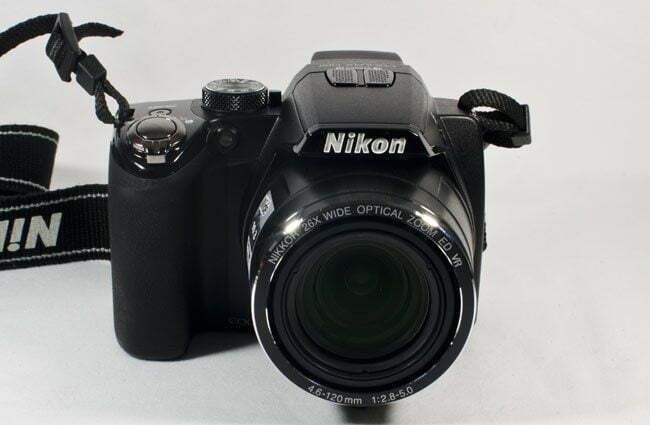
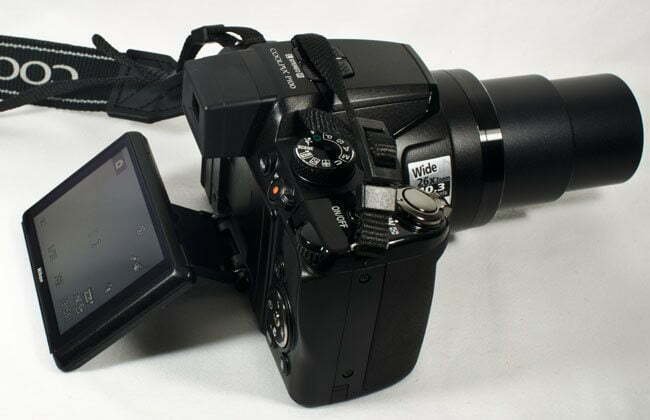



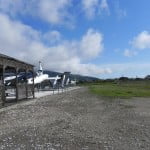
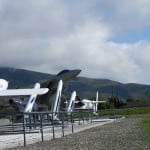


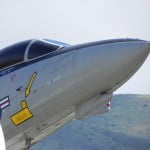




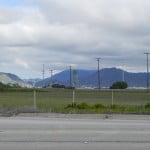



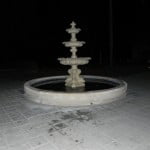
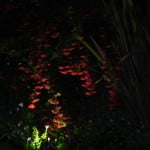
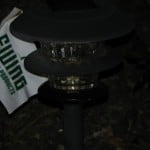
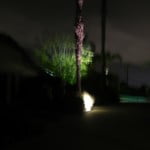

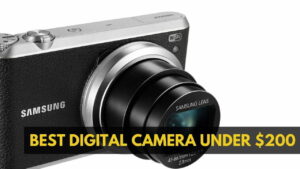
![Best Point and Shoot Under 500 Cameras in [year] ([month] Reviews) 2 Find the best point and shoot for under $500.|Finding a viewfinder is a great feature in a point and shoot camera like the Canon PowerShot G16.|Panasonic's Lumix FZ70 offers an impressive 60X optical zoom lens at a good price point.|The tiltable display screen on the Nikon P7700 is a great option for shooting photos with a tripod.|Canon has given the PowerShot SX710 WiFi capabilities and a 30X optical zoom lens.|Plenty of strong features highlight the Nikon Coolpix B700](https://www.gadgetreview.dev/wp-content/uploads/best-point-and-shoot-under-500-300x169.jpg)
